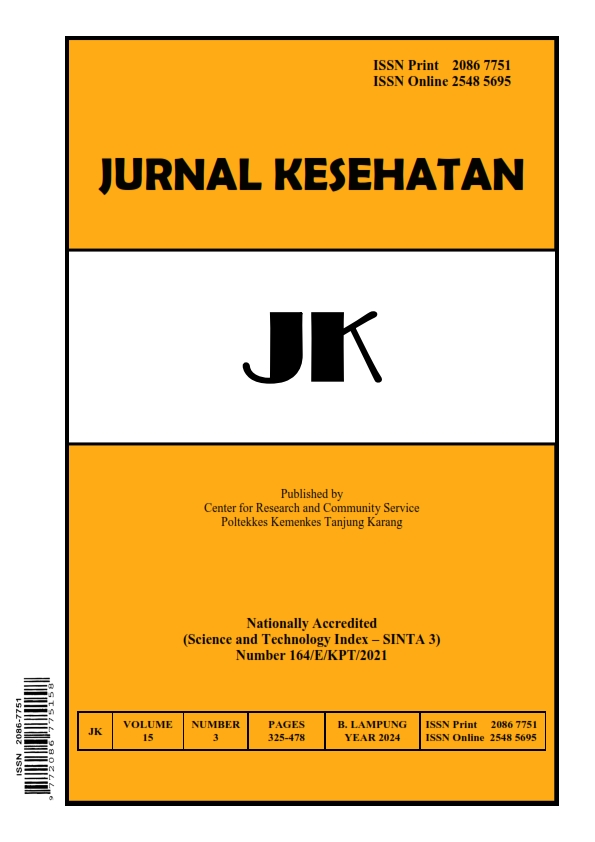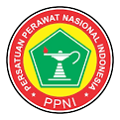Associated Factors of Father Involvement in Stunting Prevention in Toddlers Based on Transcultural Nursing Theory
DOI:
https://doi.org/10.26630/jk.v15i3.4662Keywords:
Father's role, Malnutrition, Social cultureAbstract
Stunting is still one of the most pressing global health problems. Father involvement in childcare is needed to ensure optimal child growth and development and free the child from stunting problems. Based on transcultural nursing theory, this study analyzes factors related to father involvement in preventing toddler stunting. The study used a cross-sectional approach with a multistage random sampling technique in Jember Regency with a sample of 852 respondents. A questionnaire was used to collect data. The study was conducted for 2 weeks, from August 1, 2024, to August 15, 2024. Statistical tests were carried out using Spearman Rho with a significance of 95% (α <0.05). Statistical analysis showed that technology factors (p-value=<0.001, r score=0.297), religion, spirituality, and philosophy (p-value=<0.001, r score= 0.170; kinship and social (p-value=<0.001, r score= 0.378), cultural values, beliefs, and lifestyles (p-value=<0.001, r score=0.204); politics and law(p-value=<0.001, r score=0.360); economics (p-value=<0.001, r score=0.370)—were positively correlated with father involvement in preventing stunting in toddlers. Meanwhile, biological variables (p-value=0.054, r score=0.237) and education level (p-value=-0.067, r score=0.052) did not correlate significantly with the father's involvement in preventing toddler stunting. Current research shows that father involvement in preventing stunting in toddlers is beneficial. Public health nurses can use these results to create health promotion initiatives that encourage fathers to be more involved in child care and prevent childhood stunting. The results of this study can be used to develop health promotion programs to increase father involvement in improving stunting prevention.
References
Adhiarso, D. S., Utari, P., & Hastjarjo, S. (2019). The impact of digital technology to change people’s behavior in using the media. Digit. Press Soc. Sci. Humanit, 2(2018), 5.
Adnan, M., Kadly, A., & Lutfi, A. (2023). Relationship of Public Value to The Implementation of Stunting Policy in Bengkulu Province. Jurnal Administrasi Publik (Public Administration Journal), 13(1), 23–30. https://doi.org/10.31289/jap.v13i1.8345
Adyas, A., Handayani, S. R. W., Djamil, A., Kustiani, A., & Dalimunthe, N. K. (2023). Analysis of Risk Factors of Stunting in Toddlers. Jurnal Kesehatan, 14(1), 172–183. https://doi.org/10.26630/jk.v14i1.3701
Andayani, S. A., & Lestari, Y. D. (2024). Model Intervensi Stunting (Misting) pada Balita dengan Kejadian Stunting Berbasis Transkultural Nursing. Jurnal Keperawatan, 16(2), 703–710.
Bogale, S. K., Cherie, N., Ketema, E., & Id, B. (2022). Fathers involvement in child feeding and its associated factors among fathers having children aged 6 to 24 months in Antsokia Gemza Woreda, Ethiopia : Cross-sectional study. 1–18. https://doi.org/10.1371/journal.pone.0276565
Cabrera, N. J. (2020). Father involvement, father-child relationship, and attachment in the early years. Attachment & Human Development, 22(1), 134–138. https://doi.org/10.1080/14616734.2019.1589070
Cahyani, V. U., Yunitasari, E., Indarwati, R., & Keperawatan, F. (2019). Social Support As The Main Factor In Providing Specific Nutrition Interventions For Children Aged 6-24 Months With Stunting Events Based On Transcultural Nursing. Pediomaternal Nursing Journal, 5 (1), 77–88.
Choliq, M. I., Suwarso, L. M. I., & Andarwulan, S. (2020). Pemanfaatan Teknologi Digital Smart Care Sebagai Upaya Pencegahan Stunting Pada Balita Di Era Pandemi Covid-19 Di Kelurahan Siwalankerto. Prosiding Hapemas, 1(1), 73–78.
Harahap, H., Syam, A., Palutturi, S., Syafar, M., Hadi, A. J., Ahmad, H., ... & Mallongi, A. (2024). Stunting and Family Socio-Cultural Determinant Factors: A Systematic Review. Pharmacognosy Journal, 16(1). http://dx.doi.org/10.5530/pj.2024.16.39
Hariani, S., Masrul, M., & Elytha, F. (2019). Analisis Kebijakan Program Bina Keluarga Balita (BKB) Holistik Terintegrasi Dengan Posyandu dan PAUD di Kota Sawahlunto Tahun 2016. Jurnal Kesehatan Andalas, 8(1), 138–144.
Has, E. M. M., Asmoro, C. P., & Gua, W. P. (2022). Factors related to father’s behavior in preventing childhood stunting based on health belief model. Jurnal Keperawatan Indonesia, 25(2), 74–84. https://doi.org/10.7454/jki.v25i2.847
Hasan, A., Kadarusman, H., & Sutopo, A. (2023). Risk Factors Associated with the Incidence of Stunting in Toddlers Aged 6-24 Months. Jurnal Kesehatan, 14(1), 133–142. https://doi.org/10.26630/jk.v14i1.3769
Heriawati, & Sulastri, D. (2024). Systematic Review : Hubungan Genetik Dengan Stunting. Jurnal Ners, 8, 41–48.
Ipan, Purnamasari, H., & Priyanti, E. (2021). Collaborative Governance dalam Penanganan Stunting. Kinerja, 18(3), 383–391.
Januarti, L. F., & Hidayathillah, A. P. (2020). Parenting culture on the role of father in prevention of stunting in toddler. Babali Nursing Research, 1(2), 81-90. https://doi.org/10.37363/bnr.2020.1211
Munira, S. (2023). Hasil Survei Status Gizi Indonesia (SSGI) 2022. Kementerian Kesehatan Republik Indonesia. https://promkes.kemkes.go.id/materi-hasil-survei-status-gizi-indonesia-ssgi-2022
Marsia, Juniartati, E., & Sulistyawati, D. (2023). Effectiveness of The Father Alert Android Application on Father's Knowledge and Support in Stunting Prevention in 2023. International Journal of Innovative Science and Research Technology, 8(10), 477–482.
Monterrosa, E. C., Frongillo, E. A., Drewnowski, A., de Pee, S., & Vandevijvere, S. (2020). Socio-cultural influences on food choices and implications for sustainable healthy diets. Food and Nutrition Bulletin, 41(2_suppl), 59S-73S.
Mulyaningsih, T., Mohanty, I., Widyaningsih, V., Gebremedhin, T. A., Miranti, R., & Wiyono, V. H. (2021). Beyond personal factors: Multilevel determinants of childhood stunting in Indonesia. PloS One, 16(11), e0260265.
Noor, M. S., Syarwani, M., & Putri, R. M. (2024). Healthy Environment As A Human Right : Law Enforcement To Overcome Stunting In Children. 1st Al Banjari Postgraduate International Conference: Multidisciplinary Perspective on Sustainable Development 2024, 10–20. https://doi.org/10.31602/.v0i0.15389
Nurmalasari, Y., Anggunan, A., & Febriany, T. W. (2020). Hubungan tingkat pendidikan ibu dan pendapatan keluarga dengan kejadian stunting pada anak usia 6-59 bulan. Jurnal Kebidanan, 6(2), 205-211.
Oktavia, R. (2021). Hubungan faktor sosial ekonomi keluarga dengan kejadian stunting. Jurnal Medika Hutama, 3(01 Oktober), 1616–1620.
Oryono, A., Iraguha, B., Musabende, A., Habimana, E., Nshimyiryo, A., Beck, K., ... & Kirk, C. M. (2021). Father involvement in the care of children born small and sick in Rwanda: Association with children's nutrition and development. Child: Care, Health and Development, 47(4), 451-464. https://doi.org/10.1111/cch.12856
Quraisy, C. C. R. S. A., Probandari, A. N., & Widyaningsih, V. (2024). The Relationship Between Age, Education, Region, and Knowledge with Stunting Prevention Attitudes in Brides-to-Beat the Religious Affairs Office (KUA). Nusantara Science and Technology Proceedings, 1-7. https://doi.org/10.11594/nstp.2024.4201
Rachmawati, P. D., Pradanie, R., & Dwiwardani, R. L. (2018). Factors Affecting the Feeding Pattern of Under-Five Children with Stunting in Indonesia. Children, 2(110), 79-1. https://doi.org/10.5220/0008323102290235
Rizal, M., & Hamzah, D. F. (2023). The synergy of the religious role in supporting the accelerated reduction of stunting in Kutaraja District, Banda Aceh. Jurnal Sago Gizi Dan Kesehatan, 5(1), 234–235.
Satriawan, E. (2018). Strategi Nasional Percepatan Pencegahan Stunting 2018-2024 (National Strategy for Accelerating Stunting Prevention 2018-2024). Tim Nasional Percepatan Penanggulangan Kemiskinan (TNP2K) Sekretariat Wakil Presiden Republik Indonesia, November, 1–32. http://tnp2k.go.id/filemanager/files/Rakornis 2018/Sesi 1_01_RakorStuntingTNP2K_Stranas_22Nov2018.pdf
Suniyadewi, N. W., Arief, Y. S., Kurniawati, N. D., Rismayanti, I. D. A., Trisnadewi, N. W., & Iswatun, I. (2024). Development of a Holistic Nursing Model Based on Transcultural Nursing to Improve the Quality of Life of Patients with Type-2 Diabetes Mellitus. Nurse Media Journal of Nursing, 14(1), 142-159. https://doi.org/10.14710/nmjn.v14i1.56812
Susanto, T., Rasni, H., & Susumaningrum, L. A. (2021). Prevalence of malnutrition and stunting among under-five children: A cross-sectional study family of quality of life in agricultural areas of Indonesia. Mediterranean Journal of Nutrition and Metabolism, 14(2), 147–161. https://doi.org/10.3233/MNM-200492
Tsoraya, N. D., Primalaini, O., & Asbari, M. (2022). The role of Islamic religious education on The development of youths' attitudes. Journal of Information Systems and Management (JISMA), 1(1), 12–18.
Wardani, D. W., Suharmanto, S., & Wulandari, M. (2020). Hubungan Faktor Sosial Ekonomi dan Ketahanan Pangan terhadap Kejadian Stunting pada Balita. Jurnal Kesehatan, 11(2), 287-293. https://doi.org/10.26630/jk.v11i2.2230
Yani, D. I., Rahayuwati, L., Sari, C. W. M., Komariah, M., & Fauziah, S. R. (2023). Family household characteristics and stunting: an update scoping review. Nutrients, 15(1), 233.
Yunitasari, E., Winasis, N. P., & Suarilah, I. (2020). The analysis of stunting event factors in children aged 24-59 months based on transcultural nursing. EurAsian Journal of BioSciences, 14(2), 2715-2720.
Downloads
Published
Issue
Section
License
Copyright (c) 2024 Superzeki Zaidatul Fadilah, Dwi Indah Lestari, Ishana Balaputra

This work is licensed under a Creative Commons Attribution-ShareAlike 4.0 International License.
Authors who publish in this journal agree to the following terms:
- Authors retain copyright and grant the journal right of first publication with the work simultaneously licensed under a Creative Commons Attribution License (CC BY-SA 4.0) that allows others to share the work with an acknowledgment of the work's authorship and initial publication in this journal.
- Authors can enter into separate, additional contractual arrangements for the non-exclusive distribution of the journal's published version of the work (e.g., post it to an institutional repository or publish it in a book), with an acknowledgment of its initial publication in this journal.
- Authors are permitted and encouraged to post their work online (e.g., in institutional repositories or on their website) prior to and during the submission process, as this can lead to productive exchanges and earlier and greater citations of published work.












